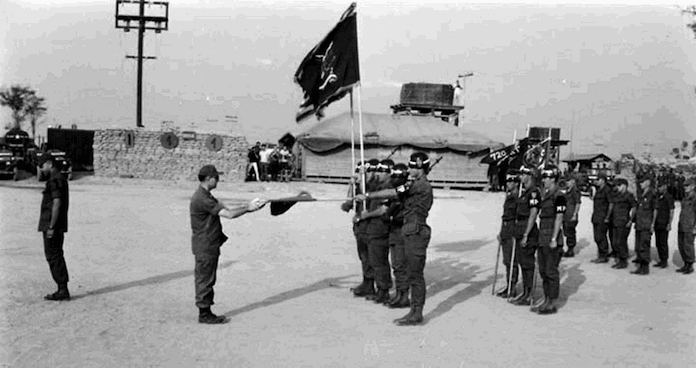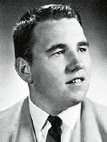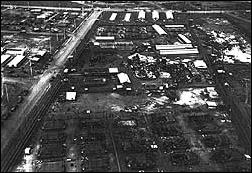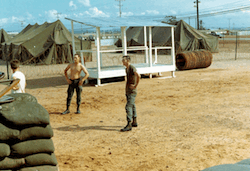Under the withering fire they spotted a small hooch just off the
roadway, picked up another severely wounded MP and drug him towards
the hooch. Just as they arrived an enemy grenade exploded about six
feet away wounding them both. The enemy first attempted to rush them
from the front and SP4 Murphy turned the attack with his M16. Another group of NVA
then tried an attack from the rear and SSG Frazier killed all three.
Despite their wounds and being short of ammunition, the two MP’s
managed to hold their position until additional help came 30 minutes
later in the form of several 25th Infantry Division MP’s.
The C Company MP escorts of the first serial dropped their vehicles at Tay Ninh and immediately
returned to the ambush site to come to the assistance of their brothers.
The second enemy objective appeared to be the destruction
of the radios on the MP and Transportation escort jeeps. This was accomplished by highly effective
small arms fire, automatic weapons fire, mortar and rocket propelled
grenade (RPG) fire. Prior to the loss of communications, air support
(helicopter light fire teams) and ground reaction forces had already been requested. There were no helicopter gunship escorts on the convoy this day due to the overcast weather and other priority assignments.
Relief elements
consisting of Company C, 4th Battalion 23rd Infantry Mechanized,
who were stationed one mile south of the ambush site on Highway QL-22, Company C, 3rd Battalion, 22nd Infantry, and B Troop, 3rd Squadron,
4th Armored Cavalry arrived and joined in the fight.
Heavy contact along the convoy line was maintained from the initial attack
at 1145 hours until 1430 hours. The NVA were well entrenched in spider holes and bunkers built in the rubber trees. The enemy continued to press the attack on groups of disabled trucks only to be repulsed by the truckers.
With a lack of air support due to low cloud cover and the enemy fortified positions in the rubber trees greatly slowing their ability to reach the convoy line, the heavy contact continued
until approximately 1700 hours when the relief units had to initiate withdrawal from the trees to regroup and resupply their depleted ammunition. Before they could launch the new assault, darkness and heavy monsoon rains again delayed their regrouping. By then the enemy assault had faded to pockets of sporadic contact along the convoy line.
The efforts of the dismounted fighting MP’s
and truck drivers in the initial phases of the ambush were credited
with preventing the entire convoy from being overrun and destroyed during
the first 30 minutes of the battle. Now with darkness, monsoon rains, and the relief columns at both the north and south ends of the highway stalled, the truckers and MP's had to face an uncertain night with little to no ammunition or chance of resupply. The pockets of truckers and MP's were scattered along the convoy line and the enemy had gained access to several of the ammunition trucks and were off loading cargo.
Occasional breaks in the cloud cover allowed helicopter gunship's to attack the enemy trench lines with rockets and machine guns giving the trapped truckers and MP's some breathing room while they waited for daylight to approach.
By 0600 hours the following morning, the relief units aided by helicopter gunship's started their assault on the enemy positions and by 1000 hours the enemy had been cleared from the kill zone and the trapped truckers and MP's relieved.
During the ambush there were two Americans taken prisoner, SP/4 Bobby L. Johnson SSG Kenneth R. Gregory, both of the 62nd Transportation Company. Both were captured late in the fight. They were held in a VC prison camp North West of Tay Ninh City. Nine months later SSG Gregory escaped and after wandering for four days in the jungle was rescued by a helicopter crew that spotted him during a routine patrol.
SP/4 Johnson remained in captivity for five years. In February 1973 he was released with most other known POW's.
A Sergeant from the US Army, 62nd Transportation Company named William W. Seay, received the Medal of Honor, posthumously.
There were 96 enemy bodies recovered from the scene of the battle. Six Americans were killed including, SP/4 Guy A. Davison, and 51 Americans were wounded, six were C Company MP's. C Company also lost
6 gun jeeps, 6 radios, and 5 M-60 machine guns destroyed.
Receiving awards on 18 November 1968 for
their heroic actions in defense of the convoy were: SSG Charles
H. Frazier, Silver Star and Purple Heart; SP/4 Albert
Murphy, Silver Star and Purple Heart; SGT Raymond H.Tate, Bronze Star for Valor.
 Wanted: Photographs of the aftermath, names, photographs and personal accounts of others on the MP escort detail, both C Company and the 25th MP Company. Please notify the History Project Manager via the Email Link at the top of this page. Wanted: Photographs of the aftermath, names, photographs and personal accounts of others on the MP escort detail, both C Company and the 25th MP Company. Please notify the History Project Manager via the Email Link at the top of this page.
|










 SP/4 Davison
SP/4 Davison

